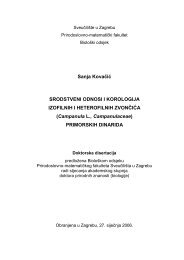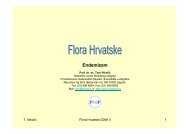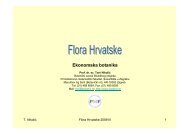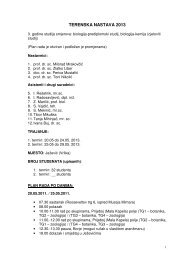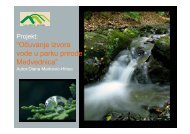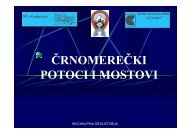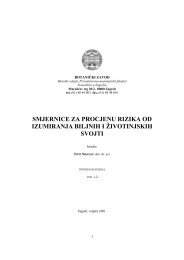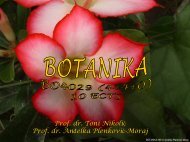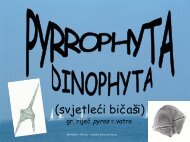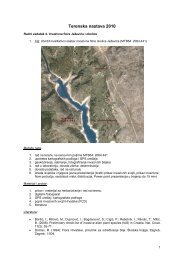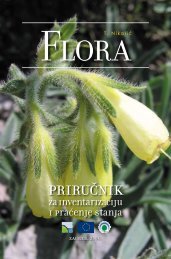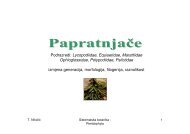important plant areas in central and eastern europe - hirc.botanic.hr ...
important plant areas in central and eastern europe - hirc.botanic.hr ...
important plant areas in central and eastern europe - hirc.botanic.hr ...
You also want an ePaper? Increase the reach of your titles
YUMPU automatically turns print PDFs into web optimized ePapers that Google loves.
Serbia <strong>and</strong> MontenegroDANKA PETROVIĆCriteria <strong>and</strong> methodologyCriterion A = 44 species were usedAi (2),Aii (10),Aiii (6),Aiv (26)Criterion B not applied <strong>in</strong> current project due to lack of dataCriterion C=49t<strong>hr</strong>eatened habitats were usedCi (6), Cii (43)The ma<strong>in</strong> challenges to apply<strong>in</strong>g the methodology were the lack of a national red lists,the representation of species <strong>and</strong> habitats <strong>in</strong> European legal documents, the translationof European habitat systems <strong>in</strong>to the national classification system, <strong>and</strong> the age of theavailable data. However potential sites were identified us<strong>in</strong>g the available data, <strong>and</strong> thegaps <strong>and</strong> priorities for future fieldwork were assessed.Protection, t<strong>hr</strong>eats <strong>and</strong> conservation issuesProtected <strong>areas</strong> cover 7.2 % of Montenegro but there are still many problems with theprotection of wild <strong>plant</strong>s. Infrastructure <strong>and</strong> tourism are major t<strong>hr</strong>eats, as aredeforestation <strong>and</strong> lack of f<strong>in</strong>anc<strong>in</strong>g for forestry management, ab<strong>and</strong>onment of l<strong>and</strong> <strong>and</strong>depopulation of rural <strong>areas</strong>, poor agricultural practises <strong>and</strong> over exploitation of wild<strong>plant</strong> resources.Recommendations■ Enlargement of the national IPA team.■ Inclusion of lower <strong>plant</strong>s <strong>and</strong> fungi <strong>in</strong>the identification of IPAs.■ National IUCN Red Lists fort<strong>hr</strong>eatened species should be prepared.■ Workshops <strong>and</strong> tra<strong>in</strong><strong>in</strong>g programmesaimed at build<strong>in</strong>g capacity should be heldfor the follow<strong>in</strong>g subjects:• Application of IUCN Red List criteria;• Application of European habitatclassification systems;• Key European <strong>and</strong> global legalframeworks, e.g. Bern Convention.■ Carry out targeted fieldwork toprovide new data <strong>and</strong> verify old data.■ Mapp<strong>in</strong>g of relevant habitats.■ Inclusion of IPAs <strong>in</strong> the nationalprotected area network with appropriatemanagement, beg<strong>in</strong>n<strong>in</strong>g with the mostt<strong>hr</strong>eatened site.ReferencesPetrović, D. 2003 Report on the NationalAnalysis of the Potential IPA Network <strong>in</strong>Montenegro, January 2003(REC Project REREP 4.3.23.1)Petrović, D. 2004 Report on the NationalAnalysis of the Potential IPA Network <strong>in</strong>Montenegro, September 2004(REC Project REREP 4.3.23.1)Bijeli Ner<strong>in</strong>iBijeli Ner<strong>in</strong>i is an IPA conta<strong>in</strong><strong>in</strong>g many t<strong>hr</strong>eatened species, water <strong>and</strong> forest habitats,<strong>in</strong>clud<strong>in</strong>g high water quality <strong>in</strong>dicator species <strong>and</strong> a quarter of the moss species known<strong>in</strong> Montenegro. The site is not currently protected.75



